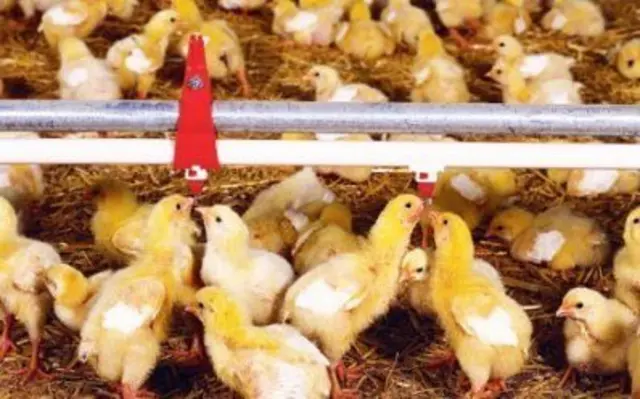The watering system in your poultry house, and how you manage it, is central to the quality of environment in which you raise your flock
This is especially true during the critical first 24 hours of a chick’s life and the following two weeks. Poor conditions during brooding will damage the flock’s performance and negatively impact results at the end of the growout.
It is vital that new chicks have immediate access to fresh, hygienic water and that their environment is as clean as possible. This article will discuss various aspects of brooding and the impact of the watering system.
Whether your water comes from a public utility or from a private well, you should test it on a regular basis for bacteria and chemicals. This is important because water conditions — especially groundwater — can change over time. You need to ensure you are giving your flock the cleanest water possible. (The water should be potable — fit for human consumption.)
Also, test well water regularly for nitrates. Nitrate-nitrogen can get into a well from rain runoff that contains animal waste or fertilizer. Nitrate itself is non-toxic, but in a chick’s stomach it can change to nitrite, which can cause an oxygen deficiency in the bird. This condition could inhibit growth or lead to death.
Well before the arrival of the chicks, there are a number of procedures you should perform to get the poultry house ready. Primary among those procedures is cleaning and checking the watering system.
Prepare the watering system with a high-pressure flush — 1.5 to 3.0 Bars (20 to 40 psi.). This flush will dislodge any biofilm in the lines, as well as any sediment buildup. Both can impact how the drinkers function.
Additionally, biofilm poses another threat to your flock. It is created when bacteria attach to a solid surface in the watering system. The bacteria exude a sticky, nutrient rich slime that attracts additional bacteria, as well as anything else in the water. The biofilm rapidly becomes an active colony of pathogens that can break off and get into your birds when they drink.
You should introduce a cleaning agent to the watering system prior to the high-pressure flush to break up the biofilm. Ziggity recommends a hydrogen peroxide based agent. After letting the cleaning agent work, flush the lines with pure water for at least one minute for every 100 feet or 30 meters.
After flushing the system, check each drinker to make sure it is functioning correctly. Replace any leaking drinkers to avoid wet litter. Also, check all other features of the watering system to make sure they are in good working order.
Again, a breakdown in the watering system during brooding can have a serious impact on flock performance.
You should strive for friable litter in your poultry house. Friable litter will clump slightly when you grab a handful and squeeze. It will then fall apart. This indicates the litter’s moisture content is about 20 to 25 percent. Wet litter will remain clumped in a ball when squeezed.
Wet litter releases ammonia that can damage a bird’s trachea, making it more susceptible to disease. Humans can detect ammonia at around 20 parts per million (ppm). Concentrations higher than that, around 50 to 100 ppm, cause the human eye to burn and tear. For chickens, the situation is even worse. Concentrations of 50 to 100 ppm can cause blindness in poultry. Even at a level of 5 ppm (undetectable to the human nose), ammonia can irritate the protective lining of a chick’s respiratory system, making it more susceptible to disease. As a practical matter, a producer cannot eliminate ammonia but Ziggity recommends you should strive to keep it below 25 ppm.
Other drawbacks of wet litter include increased foot lesions, breast blisters, skin burns and scabby areas. Any disease in the chicks takes feed energy away from meat production to fight off the condition. Additionally, any injury or unhealthy condition can persist throughout the growout, increasing downgrades and condemnations.
Wet litter also can chill the chicks. Producers need to pay close attention to the temperature in the poultry house, particularly at floor level where the young birds are. The chick’s leg skin in contact with cool, wet litter can draw off much of the bird’s core temperature. Follow the manufacturers’ instructions for setting up and operating the brooders and the ventilation system. These have a great impact on the temperature in the house and of the litter. Cool temperatures will impact performance throughout the growout.
Litter that is too dry can create dusty air conditions that can promote respiratory disease, resulting in increased production problems and reduced performance.
Set the line height and water pressure prior to the arrival of the new chicks. This is very important because if the chicks do not drink or cannot find the water, they will rapidly dehydrate. On the first day, place the chicks close to the drinkers.
Ziggity recommends that for nipple-type systems, the end of the trigger should be just slightly higher than eye level. Also, provide sufficient candlepower, enough to attract chicks to the metal pins.
Virtually all manufacturers of nipple-type drinkers without catch cups recommend using very minimal pressure settings for day-old chicks. Ziggity recommends settings as low as 2.5 cm (1 inch) of column height pressure. Manufacturers differ on pressure settings after the first week.
The first 24 hours and the first week of a chick’s life are of vital importance to how the bird will perform during the remainder of the production cycle. Anything that hampers bird growth during brooding will show up at the end of the growout because there simply is not enough time in a bird’s life to make up for the loss.
Source: Ziggity Systems, Inc.





